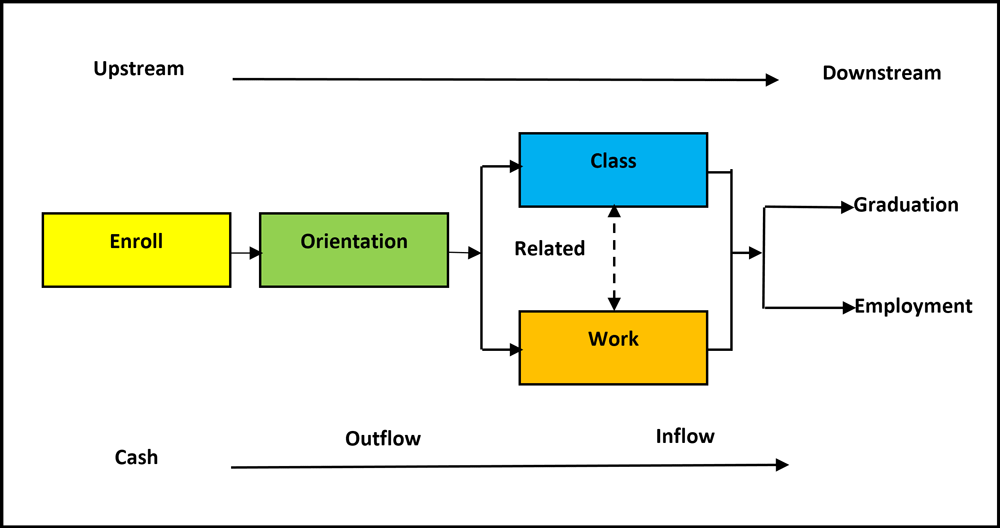ABSTRACT
The rapid progress of digital technologies and the catalyst of the COVID-19 pandemic have dramatically changed the educational environment and the way students, providers, and regulators need to organise their activities. The author describes how an education value chain (EVC) model can be used to produce better outcomes in the new environment.
The application of education value chain
Figure 1 shows a construct of a simple and general model of the education value chain (EVC) that could be used to determine the value created by educational institutions for their end users – their students and the prospective employers of their students. The three lines are drawn to represent the overall picture of the value chain, namely, the network of activities from upstream to downstream, the educational activities of students from their enrollment to graduation, and the cash flow – in and out – from the student activities.

Figure 1: Education value chain
Successful implementation of the EVC will need a paradigm change by stakeholders involved in the decision making and delivery of educational services – the regulators, the administrators, family members, the students, and the employers. They must all look at education as an investment by the students – the new generation and the future human capital of society – who will become part of the national competitive team in the global marketplace.
Historically, education has been viewed as a consumption activity, where the end game is to complete the degree, since this will enable the student to find a Job with an attractive salary. As a result, institutions provide a one-stop service, whereby the students attend classes, pass the examinations, get their degree and leave.
This one-stop service could be looked at as a supply chain, where input, process, and output are the focus of the institutions. However, when we look at education from the value chain perspective, we should also focus on the outcomes of graduate competitive ability and social responsibility awareness. It is beyond the input-process-output chain that we look at the long-term outcomes of the program and the impacts that these have on the community.
How can we capture these impacts? It can be done through the collection of big data from alumni and analysis of these data using artificial intelligence technology. Appropriate impact analysis of the EVC can help educational institutions become more competitive and contribute more to the stakeholders they serve.
The education value chain variables
Data on the variables in the EVC model can be derived from the student’s cash outflow to cover expenses associated with education from the beginning until graduation and cash inflow from work undertaken during the study period. The difference between the cash inflows and outflows represents the investment by the student. The excess of cash outflow over cash inflow is the cash cost of education, which is normally much less than the cost without work during the study period.
The cash cost includes all transaction costs including visa application and air travel costs, accommodation and living expenses, and program tuition fees. The cash inflow is mainly income from paid work or a start-up business. The estimate of cash outflow can be reasonably accurate and certain as information about it is publicly available. However, the estimate of cash inflow is subject to risk and uncertainty due to such factors as government policy relating to student employment, the demand for the student’s work, and the changing conditions in the labour market.
When the numbers have been plugged in for cash inflow and outflow, the investment figure – the cost of education – is obtained. It may be less than is popularly believed, and thus the return on investment in education may be higher and more attractive than many have realised. This difference between perception and reality is due mainly to inclusion of the work opportunity.
CONCLUSIONS AND RECOMMENDATIONS
Since this study-cum-work model is focused on investment, it should contribute to the conduct of business analyses and the formulation of plans that lead to better decisions on what, where, and how to study. It can result in a more efficient use of resources in the education sector and help close the gap between the demand for labor and the supply of graduates with requisite skills. The EVC should also allow regulators to rethink how to regulate in a way that considers alternatives, incorporates flexibility, and reflects the Generation Z lifestyle.
The same is true for the management teams of educational institutions. The EVC can be used to design an integrated service, including providing lists of available jobs and accommodation sites for the students to consider. In so doing, the institutions can provide not only knowledge but also experiences in the world of work, and thus prepare students to be more ready for their future career.
As for the students, they need to set their own personal goal by understanding themselves – what they are good at, what their passion is, and what they want in their future career. Then, they can better plan their investment in education.
For efficient planning, it is necessary for students to begin preparations early to meet the program requirement for English competency and to acquire the skills required to work alongside their colleagues in classes. They also need to understand the competencies they will need to undertake concurrent work such as being an assistant chef, providing services in restaurants, or working in the healthcare industry. They should also consider other jobs where their prior experiences might give them a competitive advantage and a higher chance of getting a job that meets their needs and preferences.
Finally, it is recommended that as the educational environment has changed with the oversupply of educational institutions, the educational model must be adjusted to meet the needs of learners by providing an education with more diverse and flexible structures.
Other issues include:
First, how can the school fees that students pay be reduced? The EVC is, in essence, a study-cum-work integrated model, offering an income generated from part-time work during a study period in order to cover educational and living expenses. The model must be structured by the institutions and implemented systematically by the prospective students.
Second, how can students graduate more quickly? ‘Abrupt’ has become a popular term describing the situation today. It refers to speed of action, which has become a competitive tool for business, including those in the education sector. To achieve speed of action, the study time in some cases could be reduced. This could be achieved by granting credit for the student’s part-time work, with evaluation being based on an analytical report of their work experiences, which the student would prepare under the supervision of their instructor. Ideally, the student’s work would be closely aligned with a component of the academic curriculum, but its suitability could be enhanced through the assignment of readings, problem-based analyses, and case studies.
Finally, since learning in the classroom alone may no longer meet the learners' needs, how can it be made easier for students to access learning through educational technology? Hybrid learning – a combination of onsite and online learning – may be the answer. It may also be necessary for institutional competitiveness.
REFERENCES
Dobzhansky,T. (1962). Mankind evolving (pp 150-162) New Haven: Yale University Press.
Robertson, R., & White. K.E. (2007). What is globalization? The Blackwell companion to globalization, pp 54-66.
Berners-Lee, T., Cailliau, R., Luotonen, A., Nielsen, H.F., & Secret. A (1994). The world-wide web. Communications of the ACM, 37(8). 76-82.
Stadtler, H. (2015). Supply chain management: An Overview. Supply chain management and advanced planning: Concepts, models, software, and case studies, pp3-28.
Chyi Lee, C., & Yang, J. (2000). Knowledge value chain. Journal of management development, 19(9), pp 783-794.
https://costofliving.studyaustralia.gov.au: Cost of living for overseas students in Australia.
https://www.ubss.edu.au/brochures/. Prices for all UBSS courses.
https://www.ubss.edu.au/media/4565/transformational-leadership-is-the-new-reality.pdf. Whateley. G. (February 2023) Transformational Leadership is the new reality.
BIOGRAPHY

Dr Om Huvanandana, based in Thailand, is an Adjunct Professor and a member of Academic Senate at UBSS. He is also a Fellow of the Centre for Scholarship and Research.




